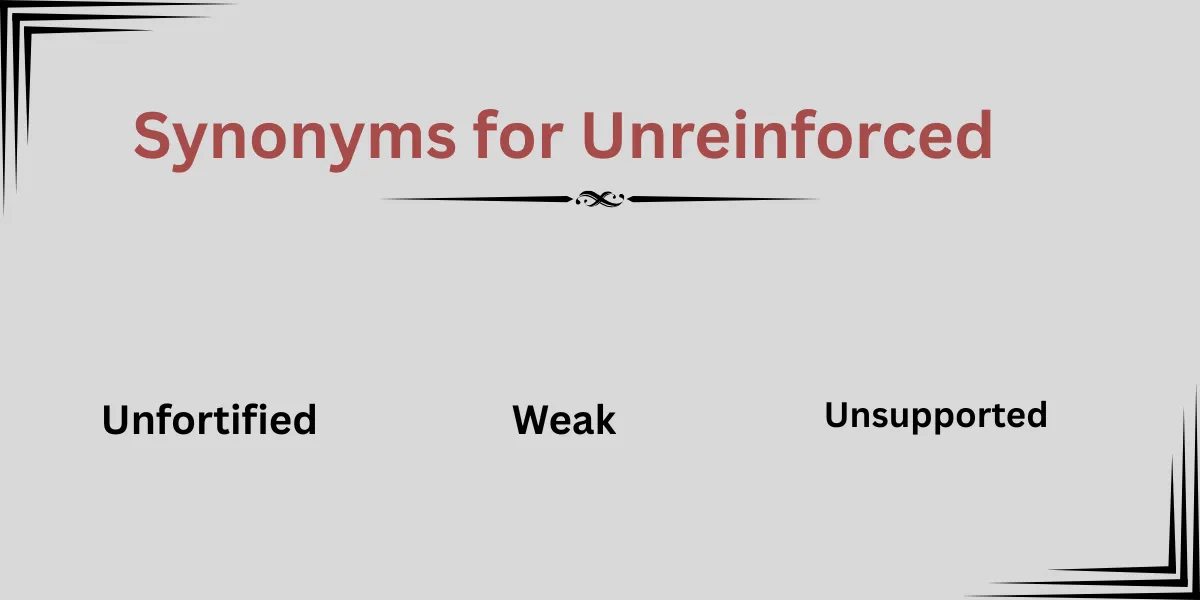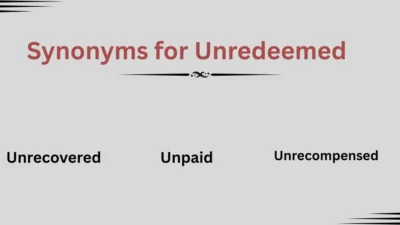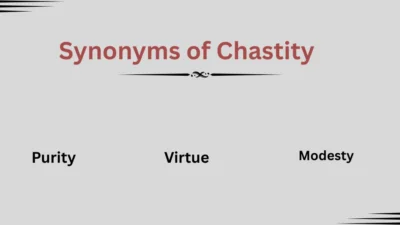Synonyms for unreinforced, such as unsupported, weak, and unstrengthened, describe objects, structures, or systems lacking additional support or reinforcement. For example, an unreinforced wall may be more vulnerable to pressure, stress, or environmental forces.
Using the right synonym for unreinforced helps you communicate clarity and precision in construction, engineering, writing, or everyday descriptions. Each term highlights a slightly different nuance, from structural weakness to lack of backup or strengthening.
If you’re writing about materials, safety, engineering, or figurative weakness, choosing synonyms for unreinforced makes your content more accurate, informative, and easy to understand.
In this guide, we’ll explore 30 alternatives, their meanings, and how to use them naturally.
What Does Unreinforced Mean?
Unreinforced describes something that lacks additional support, strength, or backing, making it more vulnerable to stress, damage, or failure. The term is often used in engineering, construction, and figurative language.
Unreinforced structures or systems are often associated with:
- Weakness – less capable of withstanding pressure or force
- Vulnerability – prone to damage, collapse, or failure
- Lack of support – no additional reinforcement, bracing, or backup
- Fragility – easily compromised under stress or strain
It’s not just about being simple — unreinforced emphasizes the absence of added protection or strength, whether referring to physical structures, materials, or metaphorical situations.
Synonyms & Related Words for Unreinforced (And When to Use Them)
1. Unsupported
Description: Lacking backing, strength, or help.
Example: “The bridge’s unsupported beam raised safety concerns.”
Usage: Neutral; suitable in both literal and figurative contexts.
2. Weak
Description: Lacking strength, firmness, or resilience.
Example: “The argument was weak and unconvincing.”
Usage: Broad; works in casual and professional contexts.
3. Unfortified
Description: Not strengthened or protected.
Example: “The unfortified walls collapsed in the storm.”
Usage: Formal; common in historical, architectural, or literary contexts.
4. Fragile
Description: Easily broken, delicate, or vulnerable.
Example: “The fragile scaffolding required immediate reinforcement.”
Usage: Emphasizes vulnerability; works both literally and figuratively.
5. Unstrengthened
Description: Not made stronger or more resilient.
Example: “The unstrengthened foundation could not bear heavy loads.”
Usage: Technical or literal; emphasizes absence of reinforcement.
6. Delicate
Description: Lacking robustness; sensitive or easily damaged.
Example: “The delicate structure swayed in the wind.”
Usage: Gentle tone; often used figuratively or descriptively.
7. Flimsy
Description: Thin, weak, or poorly constructed.
Example: “The flimsy roof gave way under the weight of snow.”
Usage: Informal; conveys weakness clearly and vividly.
8. Rickety
Description: Shaky, poorly supported, or unstable.
Example: “The rickety ladder wobbled dangerously.”
Usage: Casual; often used for physical structures or informal descriptions.
9. Feeble
Description: Lacking strength, force, or effectiveness.
Example: “His feeble attempt to support the claim failed.”
Usage: Formal or literary; conveys weakness in ability or structure.
10. Unarmed
Description: Without protection or support.
Example: “The unarmed bridge had no steel reinforcement.”
Usage: Technical or metaphorical; emphasizes vulnerability.
11. Vulnerable
Description: Open to harm, attack, or failure.
Example: “The vulnerable wall needed immediate reinforcement.”
Usage: Figurative or literal; conveys susceptibility.
12. Unbacked
Description: Not supported by additional strength, evidence, or resources.
Example: “The plan was unbacked by research or expert advice.”
Usage: Formal; works for arguments or physical structures.
13. Bare
Description: Lacking covering, protection, or additional support.
Example: “The bare concrete could not withstand stress.”
Usage: Descriptive, neutral; works literally and figuratively.
14. Unbraced
Description: Not supported with braces or reinforcements.
Example: “The unbraced framework was unsafe during construction.”
Usage: Technical, literal; conveys lack of structural support.
15. Inadequate
Description: Insufficient to meet requirements.
Example: “The inadequate wall crumbled under pressure.”
Usage: Neutral or critical; good for engineering or figurative critique.
16. Unprotected
Description: Lacking defense or reinforcement.
Example: “The unprotected bridge deck was at risk of collapse.”
Usage: Literal or figurative; emphasizes exposure to damage.
17. Unshored
Description: Not propped up with supports or shores.
Example: “The unshored excavation walls were dangerous.”
Usage: Technical, engineering-focused; specific to construction contexts.
18. Shaky
Description: Unstable or poorly supported.
Example: “The shaky scaffolding worried the workers.”
Usage: Informal; conveys instability clearly.
19. Unsound
Description: Lacking solidity or reliability.
Example: “The unsound floor could not hold heavy furniture.”
Usage: Formal; often used for arguments, logic, or structures.
20. Unreinforced concrete (literal term)
Description: Concrete without steel reinforcement.
Example: “Unreinforced concrete is prone to cracking under stress.”
Usage: Technical; literal construction context.
21. Loose
Description: Not firmly fixed or supported.
Example: “The loose beams made the roof unsafe.”
Usage: Informal; literal and figurative.
22. Precarious
Description: Not securely held or likely to collapse.
Example: “The precarious bridge swayed with every gust of wind.”
Usage: Dramatic; conveys imminent risk.
23. Insufficient
Description: Not enough for the intended purpose.
Example: “The insufficient supports could not bear the load.”
Usage: Neutral, factual; technical or evaluative contexts.
24. Unbolstered
Description: Lacking additional strength or support.
Example: “The unbolstered wall could not resist the storm.”
Usage: Formal, literary; emphasizes absence of reinforcement.
25. Weakly supported
Description: Having minimal or fragile support.
Example: “The weakly supported bridge needed urgent repair.”
Usage: Neutral; descriptive or evaluative.
26. Defenseless
Description: Open to harm due to a lack of protection.
Example: “The defenseless structure could not withstand the earthquake.”
Usage: Figurative or literal; conveys vulnerability.
27. Frail
Description: Physically or structurally weak.
Example: “The frail roof sagged under the snow.”
Usage: Gentle, descriptive; often used in literary contexts.
28. Unstrengthened frame
Description: A structure without reinforcing elements.
Example: “The unstrengthened frame buckled under pressure.”
Usage: Technical, literal; construction context.
29. Rickety framework
Description: Shaky or poorly supported structure.
Example: “The rickety framework needed immediate attention.”
Usage: Informal; visual, descriptive.
30. Susceptible
Description: Likely to be affected or harmed due to a lack of reinforcement.
Example: “The wall was susceptible to cracking in heavy rain.”
Usage: Formal, evaluative; figurative or literal.
How to Choose the Right Synonym
When selecting a synonym for unreinforced, consider tone, context, and specificity:
- Technical/Engineering: Unreinforced concrete, unbraced, unshored, unstrengthened frame
- Formal/Professional: Unsupported, unfortified, unsound, inadequate
- Casual/Descriptive: Rickety, flimsy, shaky, loose
- Vulnerability/Exposure: Defenseless, susceptible, fragile, precarious
Use the more literal terms for construction, engineering, or physical structures. Choose figurative or evaluative synonyms when describing arguments, plans, or metaphorical weaknesses. Informal, vivid terms are perfect for storytelling or descriptive writing.
Conclusion
Synonyms for unreinforced help you describe things that lack strength, support, or reinforcement with accuracy. Words like unsupported, weak, and unstrengthened each highlight a different aspect of fragility or vulnerability.
Using the right unreinforced synonym allows you to communicate ideas clearly in engineering, construction, or everyday language.
These alternatives for unreinforced make your writing more precise, expressive, and easier for readers to understand, whether you’re describing structures or symbolic weaknesses.



